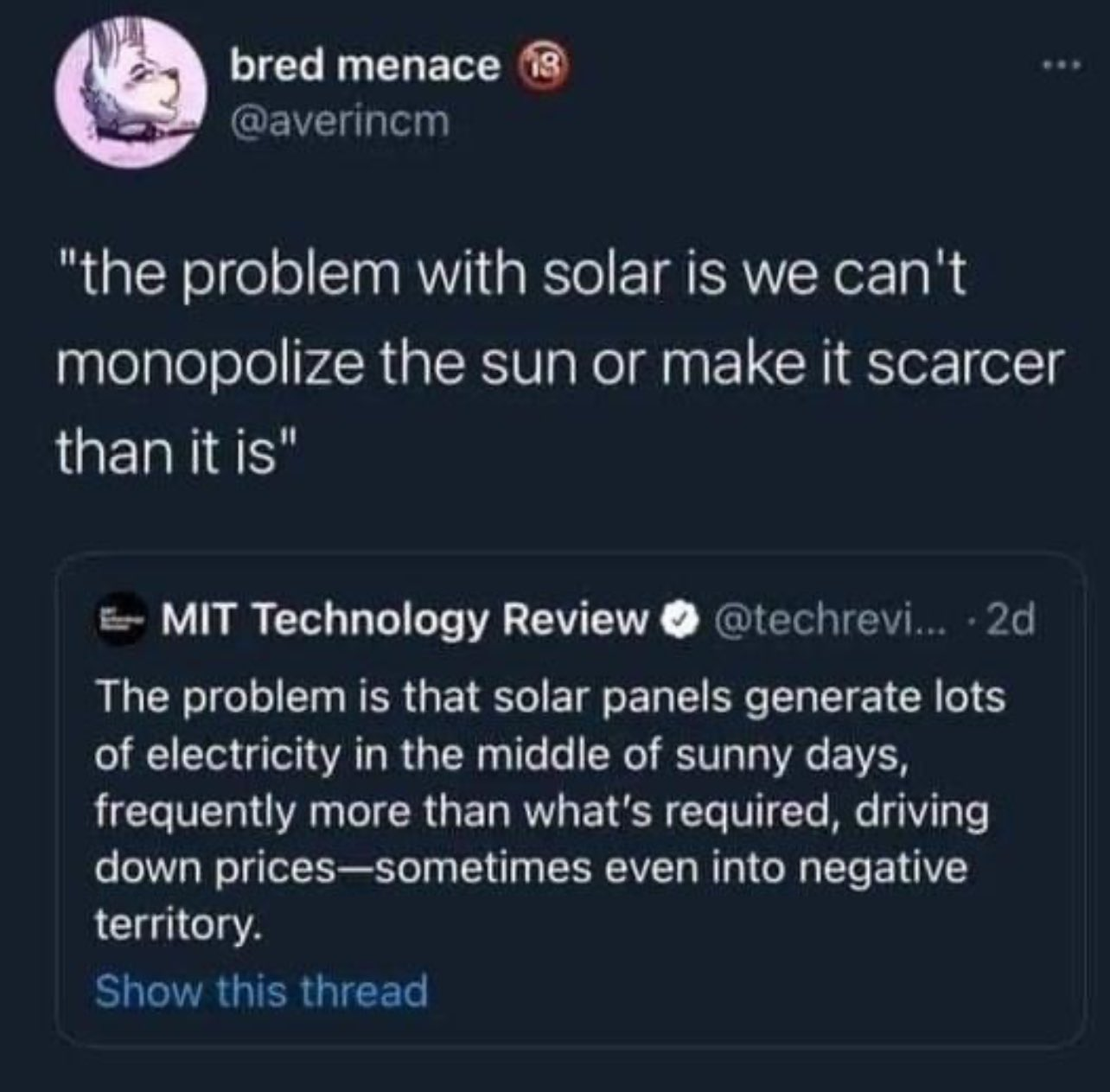this post was submitted on 02 Oct 2024
1688 points (95.6% liked)
Microblog Memes
5878 readers
4636 users here now
A place to share screenshots of Microblog posts, whether from Mastodon, tumblr, ~~Twitter~~ X, KBin, Threads or elsewhere.
Created as an evolution of White People Twitter and other tweet-capture subreddits.
Rules:
- Please put at least one word relevant to the post in the post title.
- Be nice.
- No advertising, brand promotion or guerilla marketing.
- Posters are encouraged to link to the toot or tweet etc in the description of posts.
Related communities:
founded 1 year ago
MODERATORS
you are viewing a single comment's thread
view the rest of the comments
view the rest of the comments

Call me stupid, but why don't they just charge enough to cover costs and a bit of profit? The current pricing model is broken if you can't run a solar plant profitably.
It is all quite complicated.
A renewable producer (e.g. solar panels) cannot produce energy 24/7. And when it produces energy, you are not guaranteed the production is stable.
A consumer cannot consume energy 24/7. And when they consume energy, you are not guaranteed the consumption is stable.
To make the issue worse, a producer may not be producing energy when the consumer wants it, and vice versa.
Currently, energy storage is not widely installed. Hence any produced energy must be consumed at the same time.
The factors above combined means that there will be a mismatch. If the production is too great, your electricity appliances will probably explode and whatnot. If the consumption is too great, you experience blackouts. Neither are desirable.
Now consider there is a middleman. The grid. Producers sell energy to the grid. Consumers buy energy from the grid.
At some point in time, due to the factors above, the grid will need (A) zero to negative prices to encourage consumers to buy & use more energy from it, and to encourage producers to produce & sell less energy to it. Or (B) increased prices to encourage consumers to buy & use less energy and producers to produce & sell more energy. A flat price is not realistic. (Residential users only have a flat rate because our demand patterns are more stable.)
But due to the production patterns of renewable energy and consumption patterns of our society, there is a not-insignificant risk that renewable producers will consistently face scenario (A) above making it difficult to cover back the costs.
Number 2 is not inherently true. We can incentivize time-of-use, and push it to time-of-generation. Not with all loads, of course, but with a lot of them, and a lot of very heavy loads.
Our old nuclear/coal model pushes a lot of these loads overnight to reduce daytime demand and "level the curve". Steel mills and aluminum smelters often operate overnight and shutdown during the day, because that is what nuclear and coal needed.
With solar and wind becoming predominant, we need to reverse those overnight, "off peak" incentives, and push consumption to daytime hours.
The concept is known as "demand shaping". It is an underutilized method of matching production and consumption, but it is essential if solar and wind are to become our primary source of power.
Because who would pay 10 cents per kilowatt hour when there's someone else who will pay someone to take that energy off their hands?
The problem is caused when the market clearing price is lower than the cost it took to produce it, and some of those costs are in the past.
It's like getting a boat and going fishing. If you pay $10,000 for the cost of the trip, and bring back $8,000 worth of fish, you can't just force people buy them from you for a 25% markup.
The state of California has a great live and historical dashboard of power production and consumption that you can click around in to get an intuitive sense of where the problems arise. We have more batteries than anywhere else in the world but it’s still nowhere near enough. CAISO daily outlook
Edit: the supply dashboard is more useful for this discussion: CAISO supply
It takes hours to days to start, stop, or change nuclear and coal generation rates. You can't just turn it on and off as needed. If you need coal or nuclear to meet overnight demand, you have to leave it running during the day as well. If you need 2MW of power overnight and 5MW during the day, you can only add 3MW of solar generation before you are putting too much power on the grid. If your solar puts out 5MW, you have to find out something to do with the extra 2MW that your nuclear plant needs to output continuously.
If you size your solar plants to produce 3MW in the middle of winter, then in summer they are putting out about 9MW. What can you do with the 6MW excess?
There is no single solution to manage every issue, but the single most important is "demand shaping". We need to reduce demands that can only be met with baseload generation. We need to move that demand to peak solar production times. We need to increase daytime demand to incentivize greater investment into solar. We need east/west transmission lines across every continent, shifting power from wherever the sun is up to wherever the sun is down.
Storage has to be a very distant second. Every 1 MW we time shift from night to day takes 2MW of load off the grid.